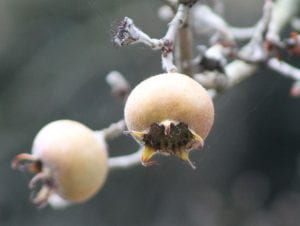By Susan Stephens
 As autumn approaches winter, the flamboyant colours of the flowers in the garden recede and the fiery colours of the leaves together with the black, white, red, purple and yellow of berries and fruits come to the fore.
As autumn approaches winter, the flamboyant colours of the flowers in the garden recede and the fiery colours of the leaves together with the black, white, red, purple and yellow of berries and fruits come to the fore.
The Medlar (Mespilus germanica) is a small tree overlooking the pool below the terrace and at this time of year is covered in small golden fruits. The appearance of the fruit has led to it being likened to a dog’s bottom or the ruder French version ‘cul de chien’! Despite its name the Medlar is endemic to Persia (Iran), South East Asia and South West Europe and not Germany. The Romans and Greeks are thought to have grown Medlars and brought them to Britain and it is believed that they have been in cultivation for longer than 3,000 years. The fruit was a delicacy in Britain in Medieval times and a winter treat before sugar was discovered, as well as an important source of Vitamin C when very few other fruits would have been available. The Medlar’s popularity declined in the Victorian era as other fruits became more popular.
Medlars cannot be picked and eaten ripe from the tree but must first be ‘bletted’. The medlars should be harvested in mid November when the fruit is very hard and tart to taste. They are then stored in a cool, dark place in a single layer with good ventilation. On sand in old mushroom boxes is a good option. They should be left for around three weeks by which time they will have turned brown and mushy with a smell and taste like an over ripe date. The fruit can be scooped and eaten straight from the skins or mixed with a little cream or yoghurt. It can also be used to make medlar jelly or medlar cheese. Why not have a go at making some yourself!
Recipe for Medlar Jelly
Ingredients (for 6 large jam jars)
· 3 small, sharp apples or 20-25 crab apples
· 2.5kg bletted medlars(see below)
· 600g firm medlars
· 4 lemons
· 3 litres water
· 1.2kg granulated sugar
(Optionally, you can add about 20 cloves at the beginning which are removed when you strain. They make the jelly a bit more Christmassy.)
Instructions
1. The bletted medlars should be dark and soft before you start. Clean them by removing any stalks and leaves and chopping them in half. Remove any really obvious rotten bits.
2. Cut the lemons and apples into quarters (just halve crab apples if you are using those instead). Then put all the fruit into a large saucepan, such as you would use for jam making.
3. Pour all the water over the fruit and bring to the boil. Once boiling, reduce the heat and cover with a lid. Leave to simmer gently for about an hour.
4. Don’t boil hard, and keep covered so the water doesn’t evaporate.
5. Every 10-15 minutes squash the fruit with a wooden spoon. Don’t over squash or stir the whole time as your jelly will end up cloudy (the taste is unaffected though).
6. Pour the whole mess into a colander lined with muslin placed over a bowl and leave overnight so that the juice drips into the bowl.
7. For the clearest jelly, do not squeeze at all. If you leave it overnight, almost all the juice will have run through by itself anyway
8. Measure the juice, which should be clear and a wonderful amber-rose colour, into a suitably sized clean saucepan and boil hard for 6-7 minutes. Then add an equal amount of sugar (which should be about 6 cups or 1.2kg).
9. Bring back to the boil and stir until the sugar has completely dissolved. Boil hard for another 2-3 minutes and test on the back of a spoon for setting.
10. When it has just begun to set (medlar jelly is best with a soft as opposed to hard consistency) pour or ladle into sterilised, warm jars and seal. Leave to cool


What about the sugar?!
Thank you Alison, a bit of valuable information missing; all ok now!